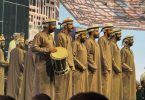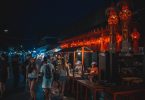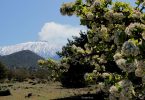UZBEKISTAN (eTN) – My quest for finding ecotourism and cultural tourism examples in Uzbekistan compelled me to continue my travel. After leaving Samarkand, my next stop was Bukhara from where I traveled to Khiva – The open Museum of Central Asia.
Cultural tourism is one of the largest and fastest-growing forms of global tourism, and Uzbekistan and other Central Asian countries are leading in cultural tourism products, because the locals preserved their culture successfully despite the rule of the former Soviet Union. Credit also goes to this rule, because Russians played a pivotal role in restoring and preserving Muslim culture.
The relationship between tourism and culture is very strong, and together they have become major drivers of destination attractiveness and competitiveness. My recent travels to Iran, Azerbaijan, Uzbekistan, and Kyrgyzstan enriched me with a thoroughly well-preserved cultural experience. If you walk through the streets of old Isfahan and Baku, you feel like you are walking in the streets of Bokhara, Khiva, and Samarkand: same architectural designs, same wooden doors and carving patterns as in all these old cities. These cities have the same cultural texture. The communities have successfully preserved their cultural heritage, thereby providing a broad base for the development of tourism.
I learned a new lesson in Bukhara about Community Based Tourism (CBT) and Pro-Poor Tourism (PPT). This learning was not through any hefty book written by some top-rated expert of tourism nor was it from any international tourism workshop held in any mega hotel. My teacher was Nazira — a lady running a Bed and Breakfast (B&B) at Khusainov Street in the Lyabi Khauz area. My host in Samarkand, Mr. Ravshan of Silk Road Destinations, told me Nazira is the “Mother of Tourism” in Bokhara, and I found these words true in every sense. Traveling from Samarkand to Bukhara is best by train, instead of spending money to travel by airplane, because this travel provides you with the opporunity to see all the different colors of Uzbekistan outside your air-conditioned and comfortable train seat.
I was picked by the husband of Nazira who is running a B&B at a railways station (Vogzaal in Russian language). For running the B&B (Home Stay), Nazira’s husband works as a driver, guide, porter, and story teller while Nazira works as chef, manger, telephone operator, and also buys stocks from the market to serve dinner at her huge divan (a bigger sofa) placed under a tree in the courtyard of her house. She is a good advisor and also like a nanny or mother telling you where to go, what to see, what not to eat, etc.
She is around above 50 year olds and is an illiterate woman in the field of tourism or ecotourism. She has never attended any capacity-building workshop or training session of tourism. But she is a master of sustainable and pro-poor tourism, if you are ready to listen her carefully. Nazira told me that after the independence of Uzbekistan, there was no job left for those who were working in other parts of the former Soviet Russia. Since her husband was working in the Soviet army and was posted in Belarus, he became jobless. They both decided to offer one of their rooms to tourists when foreigners started to visiting Bukhara, mostly from Europe. Now she is running 5 rooms successfully and offers a complete home atmosphere at her place. You can even cook your food in her kitchen if you wish.
Nazira also helps widows and poor women in her area, asking them to make some handicrafts, which she then places for sale in a corner of her courtyard from which tourists usually buy these beautiful handmade items. Whatever money comes in, goes directly back to the women who made the handicrafts, without Nazira taking any commission. She also encourages young students from the university or colleges to learn different European languages and offers them work as tourist guides.
Nazira is an example that ecotourism works even without any training or capacity building. It is unfortunate that international organizations and donors spend huge amounts on the name of capacity building workshops, instead of providing help to small stakeholders who really know what to do and just need financial support. Nazira told me she wanted to provide raw material for handicrafts to more and more poor local women, but she faces the lack of finances.
It is difficult to explain and explore Bukhara in words and phrases where more than 3,000 Muslim shrines are found and a tourist can see about 170 architectural monuments spreading over a small area of around 3 kilometers. One can call Bukhara a city museum. One of the most important monuments is the dynastic crypt of Samanids – one of the first famous Muslim mausoleums in Central Asia and one of the earliest in the Orient. It was built by Ismail Samani, one of the rulers of the Samanid’s dynasty of XII century. A tourist can get lost in the beauty and tranquility of finding so much cultural beauty around him.
After Bukhara, my journey pushed me to the dirt road of Bukhara to Khiva – the abundant land of Khorezm, situated along the Amudarya River between the Kara-kum and Kizil-kum deserts. Khorezm is one of the ancient cities in the territory of Central Asia, and Khiva is a pearl of the Khorezm region.
Uzbekistan is probably one of the best countries in Central Asia with regard to air travel, railway, and road networking to remote towns and areas, and this is one of the reasons that tourism is flourishing in Uzbekistan, compared to its neighboring countries of Kyrgyzstan and Tajikistan where natural beauty is at its height, but the only reliable source of travel being road networks.
Archaeological excavations have revealed a number of cultural layers corresponding to different chronological periods, and it is possible that there were agricultural and town settlements already in the Khiva district in the middle of the first millennium BC.
Archaeologists have also managed to find traces of dwellings, pieces of ceramic dishes, and other findings, which definitely establish the time of a settlement in the lowest layer of Ichan Kala dating back to the fifth century BC – that is to say approximately 2,500 years ago. Traces of human agricultural activity have also been found around the first settlement at Khiva. Similar scenes have been found near castles at Khazarasp, Bazrkala, and Khumbuztepa, which are close to this place.
Khiva was an important stop on the ancient Silk Route. It also served as a trading post for slaves. Al Khwarizmi invented Algebra here. The old city of Khiva is a World Heritage Site and was restored by the Soviets during the 1970s and 1980s. Wooden mosques and rebuilt harems share space with souvenir shops and the rest of the tourist kitsch. The patterns on the silk scarves and women’s ankle-length quilted coats are similar to that of South Asia and Eastern Europe, reminding one of the designs seen on clothes worn by gypsy women in places as diverse as Pakistan and India, Ukraine and Armenia. There was a major exchange of artisans between South Asia, Central Asia, and eastern Europe during the 17th to 19th centuries, and this is one of the reason that the architectural touches of Lahore, Samarkand, Bukhara, Khiva, Baku, and Isfahan are so similar.
Crossing Amu Darya, a long drive begins across the featureless Kizy-Kul desert. There are legends about flies and other insects here, which could strip horses and its riders down to bones in minutes if they stopped at the wrong place.
Khiva is two-faced city: there is Dishon Kala, the “new” city that has developed around the “old” city, and then there is fortified Itchan Kala, the “old” city. Itchan Kala has a wonderful present to offer to every traveler: the most stunning architectural ensemble of the Islamic world. It seems that time stopped forever within the walls of Old Khiva. You will need a couple of days to discover the old city of Khiva, to explore it’s tiny streets. In the plan, Khiva was a settlement of irregular outline, stretching from the west to the east and extending outwards on its eastern end. From the south to the north, the distance between the extreme points of the contour of the walls of the outside Dishan-kala was about 2.5 kilometers in length and 2.5 kilometers in width. In the center of this territory was the inner town of Ichan-kala, with its location on the east. The Ichan-kala was constructed according to the ancient traditions of Central Asian town planning, as in many other towns (Lahore, Old Delhi, Bukhara, Paikend, and Shakhrizabz).
I felt very strong linguistic linkages among South Asia, Central Asia, and Eastern Europe while traveling in Bikhara and Khiva. I enjoyed the atmosphere of camaraderie stemming from people lounging in their balconies, which coincidentally sounds the same in Urdu, Balkani, and in Russian and Ukrainian. I savored the joys of winter: (the same sounds in Urdu – sarma; Persian – zima; and Russian and Ukranian – зима) with a universally cozy cup of tea that is called chai (in Urdu and Hindi), or чай (in Uzbek, Russian, and Ukrainian). Languid evenings spent in verandas (веранда) remind me of my old Lahore.
While the Russian-imposed Cyrillic script and alphabet are in use, Persian and Turkish vocabulary remains with the Uzbek, Tajik, Kazaki people. The Russian government did not change the names of streets, areas, and monuments. When Central Asia was behind the Iron Curtain of Communism, there was a misconception that communist rulers banned religion, demolished mosques, and erased Islamic monuments. However, buildings were preserved – not on religious grounds, but on the grounds of the “preservation of culture.” For instance, the Mausoleum of Mir Sayyed Bahram was burnt and then restored impeccably around 1932. Similarly, one can see Islamic culture, monuments, and mosques in perfect condition in Bokhara, Samarkand, Tashkent, Khiva, Marve, and Ashkabad. The names of roads are mostly after Muslims heroes of the likes of Taimur, Aziz Mirzo, and Babur, etc.
Spending nights in a mud house having a Western washroom with clean bedding and hot water, you feel that tourism can survive and thrive without constructing mega structures.
The following architectural monuments are worth seeing in Khiva:
Ichan-Kala: The Mosque and Madrassah of Said-bay (end of 18th-beginning of 19th centuries); it’s around the gate of Polvan Darboza
Madrassah of Allakulihan (1834/35)
Madrassah of Kutlug-Murad-Inak (1804/12)
Bridge and Caravansary of Allakulihan (19th century)
Madrassah of Abdulla Han (1865)
The Mosque and Palace of Anush Han (1657)
Tosh-Hayli (the stone lot)(of Allakulihan) (1830/36)
Ok mechet (the white mosque ) (1832/42)
The Mosque and Minaret of Juma (1788/89)
Mausoleum of Said Alauddin (14th century)
Madrassah of Muhammad Amin Han (1851/52)
Minaret of Kalta Minor (1855)
Kun’ya-Ark (1868/88)
Minaret of Tura-Murat-Tur (1888)
Madrassah of Muhammad Amin Han (1871)
Madrassah of Shirgaziz han (1718/20)
The Mosque of Boglandi (19th century)
Madrassah of Arabhan (1838)
(eTN): Ecotourism works even deeper in Uzbekistan | re-post license | post content






















